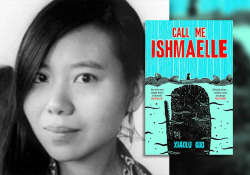Audrey Schulman in the Gutter of Genre

Genre is the most significant category in which books trade on the literary marketplace. Nonfiction or fiction. Memoir or novel. Literary fiction or romance, horror, mystery, fantasy— the latter set being the misleadingly named “genre fiction” over which the former is widely held to triumph in aesthetic beauty, stylistic accomplishment, and intellectual depth. Increasingly, as the world descended into the disorders of (post-)postmodernism, neoliberalism, globalization, and a new reign of fears about totalitarian rule, technology, and world war, the traditional accoutrements of genre fiction, the monsters and dystopias and killer robots, to name a few, found their way into the fiction of “literary” masters. “Genre” came alive in the words of those whose books slipped comfortably onto shelves between canonical works of art and literary prizewinners, far away from the mass-market paperbacks and commodified names of Stephen King, Isaac Asimov, Agatha Christie, or Nora Roberts. This has occasionally led to some of the masterworks of late twentieth-century fiction, among these George Orwell’s 1984, Toni Morrison’s Beloved, and the oeuvres of Margaret Atwood, Kazuo Ishiguro, and Thomas Pynchon. It has also led to curious experiments with the subject and settings of popular genres, especially science fiction.
“Genre” came alive in the words of those whose books slipped comfortably onto shelves between canonical works of art and literary prizewinners, occasionally leading to some of the masterworks of late twentieth-century fiction.
Audrey Schulman’s newest novel, Theory of Bastards (Europa, 2018), is just such an experiment in the gutter of genre. It’s the story of Dr. Francine “Frankie” Burke, a MacArthur Fellow and evolutionary biologist who made a career studying the evolutionary benefit behind why one in ten women have bastards. The eponymous “theory” goes that women settle with stable men with less testosterone because they tend to lead more financially secure lifestyles but occasionally cheat with more attractive, rugged men capable of producing healthier offspring. Aside from the bullshit science that universalizes the experience of a subset of (American) women to the entire species and cuts across cultural and historical differences, the novel has little to say about this theory of bastards. At the beginning of the novel, Frankie has arrived at the ailing Foundation, an ape research facility and zoo in Kansas, where she observes the sexual behavior of bonobos—chimplike matriarchal apes who have sex with anyone and anything in ritual orgies to relieve social tensions and create group cohesion before every meal. Frankie hopes to learn whether this subverts the evolutionary mainstay of “natural selection” and eventually discovers that the female bonobos have secret sexual contact with the most docile male in the group when they are ovulating.
How no one figured this out before, let alone by the time of this near-future novel some decades hence, is a mystery that belies Schulman’s general lack of interest in creating a compelling technoscientific world of the future. Frankie observes the bonobos through an array of bodywear apps, like implanted lenses that allow people to “Quark” for information, to watch videos no one else can see, to take pictures from the perspective of the user’s eyes, to disperse needed medicines through bodily implants, and so on—the Google Glasses of the future, and then some. But in this flirtation with science fiction, A Theory of Bastards is nothing if not boringly derivative of the most common tropes of near-future science fiction, barely surpassing the technophobic fear-mongering of Black Mirror (albeit lacking the occasional genius of that Twilight Zone–inspired show). Thus, the first half of the novel, aside from regular flashbacks that fill in Frankie’s life with the chronic pain of endometriosis (recently operated on, all fixed, our protagonist conveniently ready for the adventure to come), is an exercise in cutting through the uninventive play at science fiction to get to the good stuff about the bonobos.
But like Cormac McCarthy’s The Road, another “literary” novel donning the cloak of “genre,” it’s not that the novel transpires in the future that matters but that the future extrapolates the possibilities of a more geoclimactically disturbed world to allow for the otherwise unlikely liminal situations which blur and ultimately dispose of the normal boundaries of daily twenty-first-century life. In Schulman’s climate-change-ravaged future, the Midwest is hit by another Dust Bowl, complete with days-long sandstorms. About halfway through the novel, Frankie has nearly cracked the mystery of bonobo sexual selection, her recovery from the recent surgery is nearly complete, and she’s made good friends with another researcher, an archaeologist named Stotts, who is teaching bonobos to flint-knap (to show how early hominids might have learned), and whose daughter is sick but away in England for surgery. With all the pieces in place, a mandatory evacuation is called in anticipation of a major sandstorm, and everyone leaves Kansas except Frankie, Stotts, a handful of keepers, and the bonobos—domineering matriarch Mama, doofy but loyal Goliath, jealous Houdina, cute baby Tooch—we’ve grown to love.
It’s not that the novel transpires in the future that matters but that the future extrapolates the possibilities of a more geoclimactically disturbed world to allow for the otherwise unlikely liminal situations which blur and ultimately dispose of the normal boundaries of daily twenty-first-century life.
Now we’re reading a different novel. In just pages, Theory of Bastards transforms from the tedium of shallow near-future science fiction meets campus novel meets memoir of pain and reflections on an unsympathetic medical industry to postapocalyptic survival tale (with bonobos). What was a chore, offering the occasional moment of aesthetically engaging prose or intellectually stimulating reflection, becomes an enthralling work of art as Frankie and Stotts work through the sandstorm to solve the problems of keeping bonobos alive, reacting as sand trickles into the building and endangers the asthmatic animals’ lives, as the building’s electronics go haywire and food expires (the fridge turned to oven, the food-printer kaput), and as their bodywear goes offline. They are stranded, the storm ends, help never comes, food and water are gone. And despite it all, Frankie and Stotts defend and fend for the bonobos, raiding local farms to bring food back to the Foundation, dressing the apes in extra clothes to keep them warm as the weather cools, and virtually joining the bonobo troupe, while also growing intimate as humans (the distance from Stotts wife, unreachable in this new techless world, finally sealing the deal). In desperate need, they eventually flee the Foundation, heading east toward the coast, finding only the debris of a postcomputerized world.
Where Schulman floundered with the science fiction, holding it up as a B-movie setting for two hundred pages, she triumphs as a writer of complex human, animal, and human-animal relationships, revealing how we might thrive better together as an interspecies assemblage. Schulman handles the interspecies themes with aplomb, never stooping to romanticizing the human-ape connection as so much other fiction and media do. There is no suggestion in this novel that bonobos are merely humans-before-humans, apes waiting for an evolutionary nudge (much as Stotts would like), nor that humans are just advanced bonobos, separated from their orgiastic cousins by technology (again, much as Stotts would like). Rather, Schulman maintains a distinction between bonobo and human, and allows the bonobos to become characters on their own, for Burke and Stotts to become a part of the bonobo troupe without dissolving their species differences, and for the two species to adjust their expectations of interaction accordingly. The species learn to coexist, to thrive together as best they can in the postapocalyptic landscape of middle America.
And here the novel ends, the group camped out in yet another farmhouse, the kitchen and pantry raided, the beagle baying outside, the lot of them smelling of piss and sweat, bundled goofily in mismatched jackets and huddled for warmth in an interspecies scrum. The future is bleaker; the journey to the coast, then to England, long and uncertain; the dangers ahead and behind—but Burke feels no apprehension, only community and its comforts. The postapocalyptic landscape transforms into a novel of utopian possibilities shaped by the interactions of humans and bonobos who have been forced by science-fictional circumstance to transcend the great divide of keeper and kept, the semiotic distinction that once separated “man” and “animal,” and to transform the relationship into that of kin.
Where Schulman floundered with the science fiction, holding it up as a B-movie setting for two hundred pages, she triumphs as a writer of complex human, animal, and human-animal relationships, revealing how we might thrive better together as an interspecies assemblage.
I imagine we’ll see more novels like Schulman’s, as the Anthropocene forces more interactions with the creatures whose looming extinction we have wrought. If this is to be the beginning of the “human-ape novel,” of the rediscovery of our evolutionary links to other primates, and of the possibilities for futures shaped by the interactions we might have with these beings, then so be it. Where early twentieth-century novels like Edgar Rice Burroughs’s Tarzan grabbed onto the racial and evolutionary science of its day to explore whiteness, blackness, and empire through the specter of the ape’s relationship to man, the human-ape novel of the early twenty-first century might help us cope with the Anthropocene (especially if it can rid itself of the self-assured tone toward the universality of scientific claims hinted at in Schulman’s novel). As Schulman’s Theory of Bastards has shown—regardless of its place in the gutter of genre and despite the naïveté of so much “literary” fiction in its (ab)use of popular genres—this new type of novel could teach us a lot.
Michigan State University















